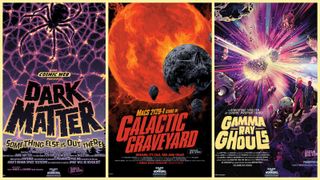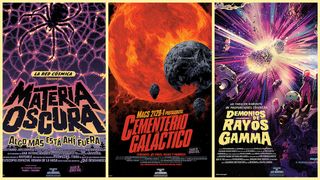Grab these spooky (and free) NASA space posters to haunt your Halloween
A Galactic Graveyard, Gamma Ray Ghouls and Dark Matter, oh, my!

If you're looking to haunt your house with some spooky space decor this Halloween, NASA's got you covered.
The space agency has three new Halloween posters depicting strange space phenomena in classic horror movie styles and they're available for free. The posters are part of the "Galaxy of Horrors" series by NASA's Exoplanet Exploration Program Office at the agency's Jet Propulsion Laboratory in Pasadena, California. You can download the three posters as PDF files here. Spanish versions are also available.
In one poster, dark matter weaves its cosmic web across the universe, invisible and elusive, just as it does in real life. In another, called the "Galactic Graveyard," the dead galaxy MACS 2129-1 haunts astronomers with its mystery of stalled starbirth shortly after the Big Bang. The mysterious beams from a powerful gamma-ray burst stars in "Gamma Ray Ghouls," the last of the new posters.
Related: Rare Halloween 'Blue Moon' is a spooky treat for us all
More: Space Halloween pumpkins a cosmic treat (photos)



The new posters join a series of haunting images released by astronomers for Halloween, as well as a "spooky playlist" of eerie space sounds collected by NASA.
"One of the things I really like about these posters is that if you spend some time studying the art and then maybe go learn a little more about each of these topics, you'll see there was a lot of thought by the artists about the choices they made to highlight the science," JPL astrophysicist Jason Rhodes, who consulted on the project, said in a statement.
The spider's web in "Dark Matter," for instance, is a reference to the cosmic filaments of dark matter weaving across our universe. Gamma-ray bursts, too, are real. They are massive explosions that could potentially harm Earth with powerful beams of radiation if one were ever aimed at our planet.

But that sort of gamma-ray burst scenario is extremely rare, astrophysicist Judy Racusin of NASA's Goddard Space Flight Center in Greenbelt, Maryland said in the statement.
"In fact, astronomers estimate that a gamma ray burst goes off in our galaxy only about once every 10,000 years, but they are visible to us only about every 10,000,000 to 100,000,000 years," NASA officials wrote. "Even then, one of these events wouldn't necessarily pose a threat to our planet."
Get the Space.com Newsletter
Breaking space news, the latest updates on rocket launches, skywatching events and more!
Racusin said the posters were created to offer a stylized view of the space phenomena to space travelers nearby.
"The poster art is a really fun way to imagine one of these happening," Racusin added. "But I wouldn't want to be those space travelers!"
Visit NASA's Galaxy of Horrors website for free, high-resolution versions of the new Halloween space posters.
Email Tariq Malik at tmalik@space.com or follow him @tariqjmalik. Follow us @Spacedotcom, Facebook and Instagram.
Join our Space Forums to keep talking space on the latest missions, night sky and more! And if you have a news tip, correction or comment, let us know at: community@space.com.

Tariq is the Editor-in-Chief of Space.com and joined the team in 2001, first as an intern and staff writer, and later as an editor. He covers human spaceflight, exploration and space science, as well as skywatching and entertainment. He became Space.com's Managing Editor in 2009 and Editor-in-Chief in 2019. Before joining Space.com, Tariq was a staff reporter for The Los Angeles Times covering education and city beats in La Habra, Fullerton and Huntington Beach. In October 2022, Tariq received the Harry Kolcum Award for excellence in space reporting from the National Space Club Florida Committee. He is also an Eagle Scout (yes, he has the Space Exploration merit badge) and went to Space Camp four times as a kid and a fifth time as an adult. He has journalism degrees from the University of Southern California and New York University. You can find Tariq at Space.com and as the co-host to the This Week In Space podcast with space historian Rod Pyle on the TWiT network. To see his latest project, you can follow Tariq on Twitter @tariqjmalik.